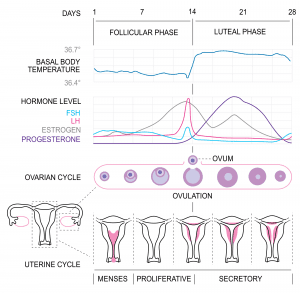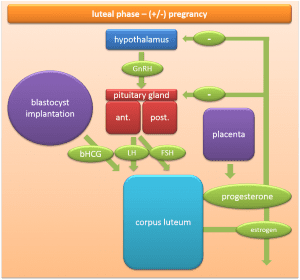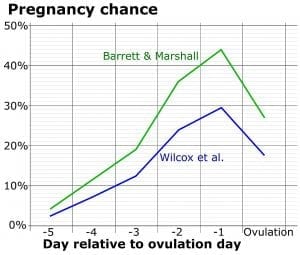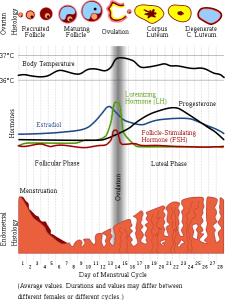You and your partner finally got your big break, and you feel that now you can afford to have a baby. So you decide to try and get pregnant. Congratulations! But you’re so excited, and you want to attempt on every technique so you can get pregnant quickly. Go, hot momma!

Let’s help you do that fast! How? First, we answer the question, “What is an ovulation calculator?” Then, let’s find out when the best chances are for you to start growing your family now.
The Ovulation Calculator
You might have heard it somewhere before, so you begin to ask around, “What is an ovulation calculator?” What does it have to do with getting pregnant? We’re here to help you find the answers to your questions.
The ovulation calculator has many names – ovulation calendar, fertility calendar, ovulation calculation, and ovulation tracker, among others. It’s a great tool to use when you want to keep track of the length of your average cycle and your luteal phase to get the most precise fertility window for you to get pregnant. It doesn’t only provide you with a rough number based on your averages, but it also allows you to place your numbers and customize it to determine your cycle. If you want to know when you’re most probably fertile within six months, you can plug in your values on the calculator and the average length of your monthly menstrual cycle.
Learning About The Luteal Phase

Let us discuss a little about the luteal phase, as it is a vital determinant of your pregnancy.
The luteal phase is the second part of your ovarian cycle, starting from ovulation and ending with either a new cycle or a pregnancy. In this stage, there is an outpour of three essential female hormones, which include:
- Follicle-stimulating hormone (FSH). The pituitary gland is responsible for releasing this hormone into the circulation to signal the ovarian follicles to secrete estrogen, and in turn to produce a mature egg.
- The function of this hormone is not so much on the egg but its protection, making sure that your uterine lining thickens at the time of implantation. It increases in number when you are pregnant.
- Luteinizing hormone (LH). This is also a hormone that originated from the pituitary gland and is released into the circulation as a result of the secretion of estrogen. The LH functions to stimulate the ovarian follicle to release the egg for possible fertilization.
The overall period of the luteal phase is 14 days or half of a woman’s 28-30 day cycle. But to be exact, you can always monitor your ovulation symptoms or urinate on some ovulation strips.
If you happen to have a shorter luteal phase, perhaps you might want to get help from your obstetrician to boosting your progesterone levels. You must remember that when this important phase is too short, your egg may be fertilized but might not make it through your fallopian tubes and into your uterus for implantation before your menstrual period comes, which negates your pregnancy.
A Few Facts About Ovulation And Fertility
Do you know when you are most fertile? If not, then you should.
Generally, a woman is most fertile on the day of her ovulation. So as the sperm can thrive for up to five days and the egg up to 24 hours only, your fertility window would be more or less six days in length. Experts commonly compare this process to a wave, where fertility starts increasing on the 10th day, spikes on the 14th, and drops down within one to two days.

And then you wonder, “When will I ovulate?” Typically, you ovulate 14 days just before your next usual menstrual period. If your cycle is irregular and you are not sure when exactly you will go through your luteal phase, then this may not be the same for you. You’ll need to monitor the signs and keep track of the changes in your body.
Firstly, know the average length of your cycle. Consult your obstetrician if you’re not sure about this. After acquiring the details on this, you can calculate for your luteal phase. Once you determine these two important details, you are now able to hit the values on the ovulation calculator to get a better picture of when you should try to get pregnant.
Calculating Your Fertile Days
Calculating for the estimated length of your menstrual cycle is the most important step to be able to calculate for your most fertile days. Next, determine your luteal phase, and when you have this information, you now calculate the time within the ovulation period, which will be your most fertile.
If we assume that you have a normal cycle, therefore having a luteal phase of 14 days, then your productive days will be between 13 and 18 days before your expected menstrual period. Using your ovulation calculator can better help you keep track of your most fertile days more conveniently and easily.
Calculating Your Ovulation Day

Finding out your ovulation day is much less complicated, as ovulation happens only on one day in a month. So if your luteal phase were 14 days, then your ovulation day would be 14 days before your next expected menstrual period. As for a 28-day cycle, on the 14th day, your egg should be released. If your information is different than the example, you can simply hit your values on the calculator and acquire your specific ovulation and fertility dates.
The Fertile Window
If you want to get pregnant quickly, then you must have sex during your fertile window, which is five days before your ovulation and on the day of ovulation itself. The fertile window is a part of your cycle where having sex would have a higher likelihood of you getting pregnant. It varies for everyone, depending on your luteal phase and cycle length. This part is where the ovulation calculator is of greatest help.
On The Side
Most of us have preferences when it comes to the gender of our baby. Moms want a baby girl for their first-born, while dads wish it would be a bay. Is there a way by which you can deliver the gender of your preference?
While most people think this is merely a myth, there is proof that can be backed by science about the timing of your intercourse. During a not so recent study, the male sperm was found to swim quicker but, at the same time, died earlier than the female sperm did under a microscope.
Now we know the answer to the question, “What is an ovulation calculator, and how does it work?” Using this information, it would be possible to conceive a girl if you and your partner have intercourse two to four days before your ovulation. If you want a boy, on the other hand, having sex on or before ovulation would increase that probability.
Ovulation Calculator FAQs
How can I calculate my ovulation period?
To calculate your ovulation period, you need to keep track of your menstrual periods. The average menstrual cycle is 28 days long, and ovulation typically occurs on the 14th day. Your fertile window is five days before you ovulate until the day of your ovulation. You may have to adjust your calendar accordingly if your ovulation period is longer or shorter than average.
How many days after your period do you ovulate?
You may ovulate between 12 to 14 days after your last period. This may vary for others as they may have a shorter menstrual cycle.
When did I ovulate based on LMP?
LMP means the last menstrual cycle. Ovulation occurs on the 14th day if your menstrual cycle is 28 days long.
How do I know if I am fertile enough to get pregnant?
Knowing when you are fertile enough to get pregnant comes with understanding and familiarizing yourself with your menstrual cycle. You can track your ovulation, as well as pay attention to the changes in your body. Some signs of ovulation include sustained basal temperature increase, breast tenderness, ovulation pain, and increased sexual desire. Likewise, there will also be a change in the texture of your cervical mucus.
What is the best ovulation app?
There are various ovulation apps available with several features that can help you track your menstrual cycle easier. The best ovulation apps are Clue, Glow, Fertility Friend, Natural Cycles, Kindara, and Period Tracker.
Why didn’t I get pregnant when I was ovulating?
If you are using apps to track your ovulation, it’s still possible for you to miss your fertile window. Moreover, factors like age, endometriosis, and male fertility also affect your chances of getting pregnant.
Is ovulation pain a good sign of fertility?
Experiencing cramps may signify ovulation. You may be in your fertile window. It is a possible sign of fertility; however, it is not the only symptom you can check to determine your fertile window.
How do you tell if you are ovulating?
Signs of ovulation include a change in your basal temperature and cervical mucus texture. You may also experience ovulation pain and an increase in libido. Your breast may feel tender, and some women’s sense of smell is also heightened.
Why does it hurt when you ovulate?
The exact cause of ovulation pain is unknown. One of the theories is that the release of blood and follicular fluid when the egg is expelled irritates the lining of the abdominal cavity. Another possible cause is the egg itself, as it bursts out of the follicle. Another reason for pain may be the spasms that occur in the uterus or fallopian tubes as the date of ovulation draws near.
Do you smell when ovulating?
The changes in your body during your cycle cause your cervical mucus to change, both in smell and texture. Some studies also suggest that a shift in how you smell is possible. Your estrogen levels spike before you ovulate, producing glycogen, which affects the pH balance of the vaginal tissue. This spike also has a positive effect on your body’s overall pH, which can make you smell better.
What happens to your body when you ovulate?
Ovulation typically happens anywhere between the 11th and 21st day of your cycle. If your ovulation period is the average 28 days, this can occur on day 14. During the follicular phase, the lining of the uterus thickens. In the ovulatory phase, the ovum moves to the fallopian tube. During the luteal phase, the luteinizing hormone is released, which triggers the release of the egg cell, and your cervical mucus will be more slippery to aid the sperm.
Last Updated on April 25, 2023 by Jeanne Meets
DISCLAIMER (IMPORTANT): This information (including all text, images, audio, or other formats on FamilyHype.com) is not intended to be a substitute for informed professional advice, diagnosis, endorsement or treatment. You should not take any action or avoid taking action without consulting a qualified professional. Always seek the advice of your physician or other qualified health provider with any questions about medical conditions. Do not disregard professional medical advice or delay seeking advice or treatment because of something you have read here a FamilyHype.com.